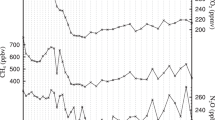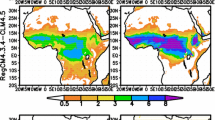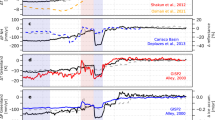Abstract
Models that predict the timing of deciduous tree leaf emergence are typically very sensitive to temperature. However, many temperature data products, including those from climate models, have been developed at a very coarse spatial resolution. Such coarse-resolution temperature products can lead to highly biased predictions of leaf emergence. This study investigates how dynamical downscaling of climate models impacts simulations of deciduous tree leaf emergence in California. Models for leaf emergence are forced with temperatures simulated by a general circulation model (GCM) at ~200-km resolution for 1981–2000 and 2031–2050 conditions. GCM simulations are then dynamically downscaled to 32- and 8-km resolution, and leaf emergence is again simulated. For 1981–2000, the regional average leaf emergence date is 30.8 days earlier in 32-km simulations than in ~200-km simulations. Differences between the 32 and 8 km simulations are small and mostly local. The impact of downscaling from 200 to 8 km is ~15 % smaller in 2031–2050 than in 1981–2000, indicating that the impacts of downscaling are unlikely to be stationary.






Similar content being viewed by others
References
Archibald S, Scholes RJ (2007) Leaf green-up in a semi-arid African savanna—separating tree and grass responses to environmental cues. J Veg Sci 18:583–594
Baldocchi D (2008) “Breathing” of the terrestrial biosphere: lessons learned from a global network of carbon dioxide flux measurement systems. Aust J Bot 56:1–26
Battles JJ, Robards T, Das A, Waring K, Gilless JK, Biging G, Schurr F (2008) Climate change impacts on forest growth and tree mortality: a data-driven modeling study in the mixed-conifer forest of the Sierra Nevada, California. Clim Chang 87(Suppl 1):S193–S213
Caffarra A, Zottele F, Gleeson E, Donnelly A (2014) Spatial heterogeneity in the timing of birch budburst in response to future climate warming in Ireland. Int J Biometeorol 58:509–519
Callaway RM (1990) Effects of soil water distribution on the lateral root development of three species of California oaks. Am J Bot 77:1469–1475
Chiang JM, Brown KJ (2007) Improving the budburst phenology subroutine in the forest carbon model PnET. Ecol Model 205:515–526
Chuine I, Cour P, Rousseau DD (1998) Fitting models predicting dates of flowering of temperate-zone trees using simulated annealing. Plant Cell Environ 21:455–466
Chuine I, Cour P, Rousseau DD (1999) Selecting models to predict the timing of flowering of temperate trees: implications for tree phenology modelling. Plant Cell Environ 22:1–13
Churkina G, Schimel D, Braswell BH, Xiao X (2005) Spatial analysis of growing season length control over net ecosystem exchange. Glob Chang Biol 11:1777–1787
Cleland EE, Chiariello NR, Loarie SR, Mooney HA, Field CB (2006) Diverse responses of phenology to global changes in a grassland ecosystem. Proc Natl Acad Sci U S A 103:13740–13744
Dickinson R, Errico R, Giorgi F, Bates G (1989) A regional climate model for the western United States. Clim Chang 15:383–422
Donner LJ, Wyman BL, Hemler RS, Horowitz LW, Ming Y, Zhao M, Golaz J-C, Ginoux P, Lin S-J, Schwarzkopf MD, Austin J, Alaka G, Cooke WF, Delworth TL, Freidenreich SM, Gordon CT, Griffies SM, Held IM, Hurlin WJ, Klein SA, Knutson TR, Langenhorst AR, Lee H-C, Lin Y, Magi BI, Malyshev SL, Milly PCD, Naik V, Nath MJ, Pincus R, Ploshay JJ, Ramaswamy V, Seman CJ, Shevlikova E, Sirutis JJ, Stern WF, Stouffer RJ, Wilson RJ, Winton M, Wittenberg AT, Zeng F (2011) The dynamical core, physical parameterizations, and basic simulation characteristics of the atmospheric component AM3 of the GFDL global coupled model CM3. J Clim 24:3484–3519
Entekhabi D, Njoku EG, O’Neill PE, Kellogg KH, Crow WT, Edelstein WN, Entin JK, Goodman SD, Jackson TJ, Johnson J, Kimball J, Piepmeier JR, Koster RD, Martin N, McDonald KC, Moghaddam M, Moran S, Reichle R, Shi J-C, Spencer MW, Thurman SW, Tsang L, Van Zyl J (2010) The Soil Moisture Active Passive (SMAP) mission. Proc IEEE 98:704–716
Fischer EM, Seneviratne SI, Vidale PL, Lüthi D, Schär C (2007) Soil moisture-atmosphere interactions during the 2003 European summer heat wave. J Clim 20:5081–5099
Fitzjarrald DR, Acevedo OC, Moore KE (2001) Climatic consequences of leaf presence in the eastern United States. J Clim 14:598–614
Flint LE, Flint AL (2012) Downscaling future climate scenarios to fine scales for hydrologic and ecological modeling and analysis. Ecol Process 1:2
Friedl MA, Gray JM, Melaas EK, Richardson AD, Hufkens K, Keenan TF, Bailey A, O’Keefe J (2014) A tale of two springs: using recent climate anomalies to characterize the sensitivity of temperate forest phenology to climate change. Environ Res Lett 9:054006
Fryer JL (2007) Quercus douglasii. In: Fire effects information system [Online]. U.S. Department of Agriculture, Forest Service, Rocky Mountain Research Station, Fire Sciences Laboratory (Producer). Available: http://www.fs.fed.us/database/feis/. [2014, August 23].
Ganguly S, Friedl MA, Tan B, Zhang X, Verma M (2010) Land surface phenology from MODIS: characterization of the collection 5 global land cover dynamics product. Remote Sens Environ 114:1805–1816
Giorgi F (1990) Simulation of regional climate using a limited area model nested in a general circulation model. J Clim 3:941–963
Gordo O, Sanz JJ (2010) Impact of climate change on plant phenology in Mediterranean ecosystems. Glob Chang Biol 16:1082–1106
Griffin JR (1976) Regeneration in Quercus lobata savannas, Santa Lucia Mountains, California. Am Midl Nat 95:422–435
Haggerty BP, Matthews ER, Gerst KL, Evenden AG, Mazer SJ (2013) The California phenology project: tracking plant responses to climate change. Madrono 60:1–3
Howard JL (1992a) Aesculus californica. In: Fire effects information system, [Online]. U.S. Department of Agriculture, Forest Service, Rocky Mountain Research Station, Fire Sciences Laboratory (Producer). Available: http://www.fs.fed.us/database/feis/ [Downloaded on 15 July 2015].
Howard JL (1992b) Quercus lobata. In: Fire effects information system, [Online]. U.S. Department of Agriculture, Forest Service, Rocky Mountain Research Station, Fire Sciences Laboratory (Producer). Available: http://www.fs.fed.us/database/feis/. [Downloaded on 15 July 2015].
Hunter AF, Lechowicz MJ (1992) Predicting the timing of budburst in temperate trees. J Appl Ecol 29:597–604
Hur J, Ahn J-B (2014) The change of first-flowering date over South Korea projected from downscaled IPCC AR5 simulation: peach and pear. Int J Climatol. doi:10.1002/joc.4098
Jeong S-J, Medvigy D, Shevliakova E, Malyshev S (2012) Uncertainties in terrestrial carbon budgets related to spring phenology. J Geophys Res 117:G01030. doi:10.1029/2011JG001868
Jeong S-J, Medvigy D, Shevliakova E, Malyshev S (2013) Predicting changes in temperate forest budburst using continental-scale observations and models. Geophys Res Lett 40:359–364. doi:10.1029/2012GL054431
Kim J (2001) A nested modeling study of elevation-dependent climate change signals in California induced by increased atmospheric CO2. Geophys Res Lett 28:2951–2954
Knorr W, Kaminski T, Scholze M, Gobron N, Pinty B, Giering R, Mathieu P-P (2010) Carbon cycle data assimilation with a generic phenology model. J Geophys Res 115:G04017
Körner C, Basler D (2010) Phenology under global warming. Science 327:1461–1462
LaMarche VC Jr, Hirschboeck KK (1984) Frost rings in trees as records of major volcanic eruptions. Nature 307:121–126
Leung LR, Mearns LO, Giorgi F, Wilby RL (2003) Regional climate research. Bull Am Meteorol Soc 84:89–95. doi:10.1175/BAMS-84-1-89
Levis S, Bonan GB (2004) Simulating springtime temperature patterns in the community atmosphere model coupled to the community land model using prognostic leaf area. J Clim 17:4531–4540
Luquez V, Hall D, Albrectsen BR, Karlsson J, Ingvarsson P, Jansson S (2008) Natural phenological variation in aspen (Populus tremula): the SwAsp collection. Tree Genet Genomes 4:279–292
Ma S, Baldocchi DD, Xu L, Hehn T (2007) Inter-annual variability in carbon dioxide exchange of an oak/grass savanna and open grassland in California. Agr Forest Meteorol 147:157–171
Maak K, von Storch H (1997) Statistical downscaling of monthly mean air temperature to the beginning of flowering of Galanthus nivalis L. in northern Germany. Int J Biometeorol 41:5–12
Matulla C, Scheifinger H, Menzel A, Koch E (2003) Exploring two methods for statistical downscaling of Central European phenological time series. Int J Biometeorol 48:56–64
Medvigy D, Walko RL, Avissar R (2008) Modeling the interannual variability of the Amazon hydroclimate. Geophys Res Lett 35:L15817. doi:10.1029/2008GL034941
Menne MJ, Durre I, Vose RS, Gleason BE, Houston TG (2012a) An overview of the global historical climatology network-daily database. J Atmos Ocean Technol 29:897–910. doi:10.1175/JTECH-D-11-00103.1
Menne MJ, Durre I, Korzeniewski B, McNeal S, Thomas K, Yin X, Anthony S, Ray R, Vose RS, Gleason BE, Houston TG (2012b) Global historical climatology network-daily (GHCN-Daily), Version 3.20. NOAA National Climatic Center. http://doi.org/10.7289/V5D21VHZ. [accessed 19 June 2015].
Menzel A, Fabian P (1999) Growing season extended in Europe. Nature 397:659
Migliavacca M, Sonnentag O, Keenan TF, Cescatti A, O’Keefe J, Richardson AD (2012) On the uncertainty of phenological responses to climate change, and implications for a terrestrial biosphere model. Biogeosciences 9:2063–2083
Moore KE, Fitzjarrald DR, Sakai RK, Goulden ML, Munger JW, Wofsy SC (1996) Seasonal variation in radiative and turbulent exchange at a deciduous forest in central Massachusetts. J Appl Meteorol 35:122–134
Morin X, Lechowicz MJ, Augspurger C, O’Keefe J, Viner D, Chuine I (2009) Leaf phenology in 22 North American tree species during the 21st century. Glob Chang Biol 15:961–975
Morin X, Roy J, Sonié L, Chuine I (2010) Changes in leaf phenology of three European oak species in response to experimental climate change. New Phytol 186:900–910
Park H, Jeong S-J, Ho C-H, Kim J, Brown ME, Schaepman ME (2015) Nonlinear response of vegetation green-up to local temperature variations in temperate and boreal forests in the Northern Hemisphere. Remote Sens Environ 165:100–108
Peñuelas J, Filella I, Comas P (2002) Changed plant and animal life cycles from 1952 to 2000 in the Mediterranean region. Glob Chang Biol 8:531–544
Pettorelli N, Mysterud A, Yoccoz NG, Langvatn R, Stenseth NC (2005) Importance of climatological downscaling and plant phenology for red deer in heterogeneous landscapes. Proc R Soc B 272:2357–2364
Richardson AD, O’Keefe J (2009) Phenological differences between understory and overstory: a case study using the long-term Harvard forest records. In Noormets A (ed) Phenology of ecosystem processes. Springer, New York, pp. 87–117. doi: 10.1007/978-1-4419-0026-5_4
Richardson AD, Hollinger DY, Dail DB, Lee JT, Munger JW, O’Keefe J (2009) Influence of spring phenology on seasonal and annual carbon balance in two contrasting New England forests. Tree Physiol 29:321–331
Richardson AD, Black TA, Ciais P et al (2010) Influence of spring and autumn phenological transitions on forest ecosystem productivity. Philos Trans R Soc B Biol Sci 365:3227–3246
Richardson AD, Anderson RS, Arain MA et al (2012) Terrestrial biosphere models need better representation of vegetation phenology: results from the North American carbon program site synthesis. Glob Chang Biol 18:566–584
Richardson AD, Keenan TF, Migliavacca M, Ryu Y, Sonnentag O, Toomey M (2013) Climate change, phenology, and phenological control of vegetation feedbacks to the climate system. Agric Fo0072 Meteorol 169:156–173
Ryu Y, Baldocchi DD, Ma S, Hehn T (2008) Interannual variability of evapotranspiration and energy exchange over an annual grassland in California. J Geophys Res 113:D09104. doi:10.1029/2007JD009263
Sanz-Pérez V, Castro-Días P, Valladares F (2009) Differential and interactive effects of temperature and photoperiod on budburst and carbon reserves in two co-occurring Mediterranean oaks. Plant Biol 11:142–151
Schwartz MD (1992) Phenology and springtime surface-layer change. Mon Weather Rev 120:2570–2578
Schwartz MD, Karl TR (1990) Spring phenology: nature’s experiment to detect the effect of “green-up” on surface maximum temperature. Mon Weather Rev 118:883–890
Schwartz MD, Betancourt JL, Weltzin JF (2012) From Caprio’s lilacs to the USA National Phenology Network. Front Ecol Environ 10:324–327
Shen M, Cong N, Cao R (2014) Temperature sensitivity as an explanation of the latitudinal patter of green-up date trend in Northern Hemisphere vegetation during 1982–2008. Int J Climatol. doi:10.1002/joc.4227
Skamarock WC, Klemp JB, Dudhia J, Gill DO, Barker DM, Duda MG, Huang X, Wang W, Powers JG (2008) A description of the advanced research WRF version 3, NCAR Tech. Note, NCAR/TN-475 + STR, 8 pp., Natl. Cent. for Atmos. Res., Boulder, Colo., U.S.A. [Available at http://www.mmm.ucar. edu/wrf/users/docs/arw v3.pdf.]
Sork VL, Davis FW, Westfall R, Flint A, Ikegami M, Wang H, Grivet D (2010) Gene movement and genetic association with regional climate gradients in California valley oak (Quercus lobata Née) in the face of climate change. Mol Ecol 19:3806–3823
Stöckli R, Rutishauser T, Baker I, Liniger MA, Denning AS (2011) A global reanalysis of vegetation phenology. J Geophys Res 116:G03020. doi:10.1029/2010JG001545
Taylor KE, Stouffer RJ, Meehl GA (2012) An overview of CMIP5 and the experiment design. Bull Am Meteorol Soc 93:485–498
USA National Phenology Network (2015) Plant phenology data for the United States, 2012–2015. USA-NPN, Tucson, Data set accessed 2015-06-17 at http://www.usanpn.org/results/data
von Storch H, Zorita E, Cubasch U (1993) Downscaling of global climate change estimates to regional scales: an application to Iberian rainfall in wintertime. J Clim 6:1161–1171
Waddell KL, Barrett TM (2005) Oak woodlands and other hardwood forests of California, 1990s. PNW-RB-245. U.S. Department of Agriculture, Forest Service, Pacific Northwest Research Station, Portland, 94 pp
Walko RL, Avissar R (2011) A direct method for constructing refined regions in unstructured conforming triangular-hexagonal computational grids: application to OLAM. Mon Weather Rev 139:3923–3937
Wolkovich EM, Cook BI, Allen JM, Crimmins TM, Betancourt JL, Travers SE, Pau S, Regetz J, Davies TJ, Kraft NJB, Ault TR, Bolmgren K, Mazer SJ, McCabe GJ, McGill BJ, Parmesan C, Salamin N, Schwartz MD, Cleland EE (2012) Warming experiments underpredict plant phenological responses to climate change. Nature 485:494–497
Xia Y, Mitchell K, Ek M, Sheffield J, Cosgrove B, Wood E, Luo L, Alonge C, Wei H, Meng J, Livneh B, Lettenmaier D, Koren V, Duan Q, Mo K, Fan Y, Mocko D (2012) Continental-scale water and energy flux analysis and validation for the North American land data assimilation system project phase 2 (NLDAS-2): 1. intercomparison and application of model products. J Geophys Res 117:D03109. doi:10.1029/2011JD016048
Zha T, Barr AG, van der Kamp G, Black TA, McCaughey JH, Flanagan LB (2010) Interannual variation of evapotranspiration from forest and grassland ecosystems in western Canada in relation to drought. Agric For Meteorol 150:1476–1484
Acknowledgments
This work was supported by the Agriculture and Food Research Initiative of the US Department of Agriculture National institute of Food and Agriculture grant 2011-67004-30224. The observed budburst data were provided by the USA National Phenology Network (http://www.usanpn.org) and the many participants who contribute to its Nature’s Notebook program. We acknowledge the World Climate Research Programme’s Working Group on Coupled Modeling, which is responsible for CMIP, and we thank the climate modeling groups for producing and making available their model output. For CMIP, the U.S. Department of Energy’s Program for Climate Model Diagnosis and Intercomparison provides coordinating support and led development for software infrastructure in partnership with the Global Organization for Earth System Science Portals. We thank two anonymous reviewers for their helpful comments.
Author information
Authors and Affiliations
Corresponding author
Rights and permissions
About this article
Cite this article
Medvigy, D., Kim, S.H., Kim, J. et al. Dynamically downscaling predictions for deciduous tree leaf emergence in California under current and future climate. Int J Biometeorol 60, 935–944 (2016). https://doi.org/10.1007/s00484-015-1086-7
Received:
Revised:
Accepted:
Published:
Issue Date:
DOI: https://doi.org/10.1007/s00484-015-1086-7




